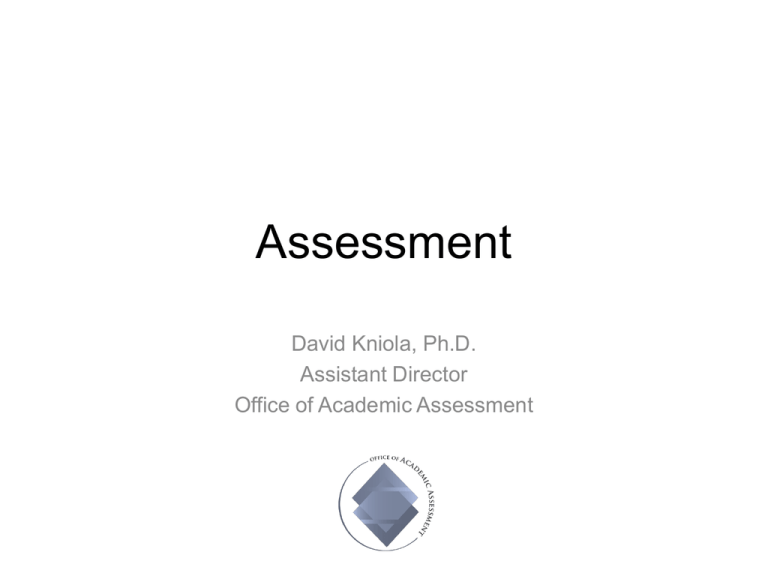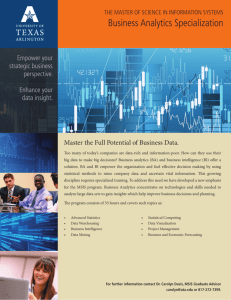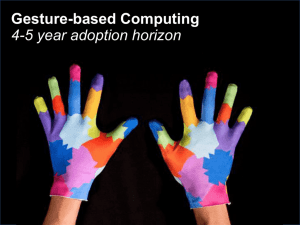Assessment
advertisement

Assessment David Kniola, Ph.D. Assistant Director Office of Academic Assessment http://www.youtube.com/watch_popup?v=6Cf7IL_eZ38&vq=medium Rising tension within and between Internal and External Where might we be headed? Within the next 2-3 years Continue current practices. • LEAP essential learning outcomes and authentic assessment. • New Leadership Alliance (http://www.newleadershipalliance.org/) Shift from quantitative to a balance with qualitative measures. LEAP report from employers wanting “context and substance.” Within the next 2-3 years Keeping eye on emerging trends: • Discerning Learning from Lumina (http://www.luminafoundation.org/publications/) • Degree Qualifications Profile (http://www.luminafoundation.org/publications/The_Degree_Qualific ations_Profile.pdf) • ETS e-rater, automated essay evaluation (http://www.ets.org/erater/about) • Targeted analytics defined by NRC doctoral program survey Transparency Framework National Institute for Learning Outcomes Assessment (NILOA) http://www.learningoutcomeassessment.org/TransparencyFrameworkIntro.htm Transformation in Assessment Diana Chapman Walsh who served as president of Wellesley College from 1993 to 2007. Essay in Inside HE: • • • • Toward a Science of Learning Advances in learning sciences and fast-changing technology Transcending new and better measures of SLOs Assessing WHAT students have learned is less valuable than finding out HOW they learn. • Polanyi’s "Learning about" involves explicit knowledge, "learning to be" is more tacit…combine with “socially constructed understanding” in digital age Transformation in Assessment Define higher education and learning in traditional university. Walsh calls for a “science of improvement.” Creation of “highly intentional learning” • • • • What is quality? What is “value added?” Do we need improvement in educational output? We have seen quality of life improvements (res halls, dining, fitness center). These have not led to educational improvements. • What is the role of land-grant? • What do these mean to VT? How do we invent our future? • Data, honest conversation, systematic research. Analytics Learning Analytics Rise of learning and business analytics • • • • How do we know if a student is struggling? Do we know what makes a student successful? What data do we have? What data do we need? Learning Analytics Learning analytics: • Utilizing performance data (grades, quizzes, tests) captured by LMS. • Purdue Signals (http://www.itap.purdue.edu/tlt/signals/) …but what if this data was augmented with data from “outside” the LMS? What if we could see patterns of data that has been captured at every interaction a student has with the university? What if this could then be used by faculty as well as students to better understand learning? Learning Analytics Identify Risks Intervention Identify Learning Awareness and growth Assessment Within the next 5-10 years • Convergence of data sources (implementation of learning analytics) • Portable and personalized assessment tools. Student or professor can deploy bot to retrieve data. Call up on mobile device. Where does student fit in relation to others? • Modeling ontologies? Simulations? • Networked assessment. Move from department/discipline to university wide. Include PK-12? A social network for assessment? • Is privacy an issue for the Facebook generation? Within the next 15 years Within the next 15 years Artificial intelligence and augmented intelligence • Assessment hinges on how we define learning? • Computers readily retrieve “answers” (e.g., Watson, which will be commercialized by IBM). • Human capabilities enhanced by interaction with computer (e.g., pattern recognition, devices as extension of our senses, decisions based on data) • Asking questions (humans) not answering them (computers) Within the next 15 years Where does that leave assessment? Possibility to explore deeper questions about student learning. If learning is individualized, assessment will need to be. Different questions important to different users: • • • • Faculty—how/what are students learning in my class? Advisors—which students need attention and guidance? Students—what am I learning and how do I compare to others? Administrators—where do we need to focus resources to support learning? • Public—are they doing what they say they are doing? Within the next 15 years Next Generation Learning Challenges (http://nextgenlearning.org/) Goal: Scale the real-time use of learning analytics by students, instructors, and academic advisors to improve student success. “That’s our challenge to you: Develop a model that identifies, improves, and scales existing solutions of learner analytics.” Within the next 15 years Think back to the Corning video. • Imagine this as a university campus. • Imagine this is what we could do with our data. • Can we build this at VT? • An interdisciplinary “meeting of the minds”: instructional design, learning technologies, brain science, education, psychology, computer science, systems engineering, OAA, CIDER, others…







